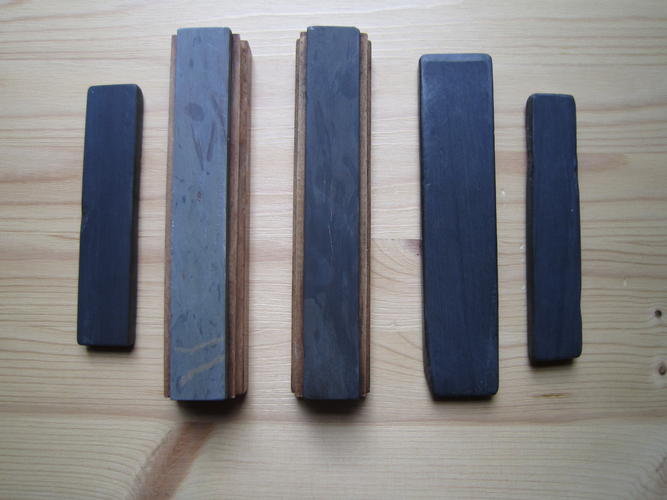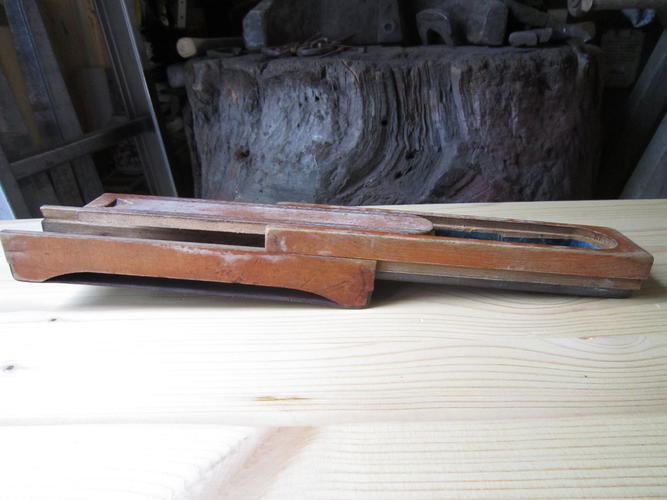Results 11 to 20 of 56
Thread: The Frankonian Hone
-
07-13-2012, 02:40 PM #11
-
07-13-2012, 02:53 PM #12
-
07-13-2012, 03:24 PM #13At this point in time...




- Join Date
- Jun 2007
- Location
- North Idaho Redoubt
- Posts
- 27,107
- Blog Entries
- 1
Thanked: 13249
After you mess with it and if you are ready to give up, Flip it over, lap in the back side, and start again

You can also try the same trick with the side you are working on, Lap heavy ie: in the 120 grit range, then do the work to bring it back up to smooth slowly... Perhaps just a slightly different layer will change the outcome...
Full Discloser: I have never even touched a Frankonian hone, this is just a system that works with many Naturals that want to be difficultLast edited by gssixgun; 07-13-2012 at 03:35 PM.
-
The Following User Says Thank You to gssixgun For This Useful Post:
stingray (07-13-2012)
-
07-13-2012, 03:50 PM #14

For me this usually means the razor isn't ready yet for the hone and I need to get back to the last hone or use another hone in between to bridge the gab. You could use slurry on the Frankonian but it may be better to find out where you at first. So unless your Frankonian doesn't have any cutting power it's a good thing it currently doesn't seem to do anything.
Modine, I don't think you can compare a Fox/Goldfisch Wetzstein to a Frankonian.
-
The Following User Says Thank You to Piet For This Useful Post:
stingray (07-13-2012)
-
07-13-2012, 09:17 PM #15

WOW!! Thanks for that.
I scuffed it up with my DMT lapping plate (the course one) and it behaves completely different. It will slurry and everything. Don't know if it will put a edge or not but at least it is doing something!!
Will keep you posted on my progress.
Stingray
-
07-13-2012, 09:28 PM #16
-
07-14-2012, 04:15 PM #17

@ Stingray,
just to clarify this a little bit:
there is not a Frakonian hone. Frankonia is an area in Germany, not a country. Most of the area of Frankonia is in Bavarian but even a part of south Thuringia is Frankonian.
As for the hones, there have been a lot of mines in the Frankonian area in the past.
Only about 5-10 miles from the thuringian main hone mining area Sonneberg-Steinach there is a famous Bavarian-Frakonian area around Lauenberg where hones have been mined in the past and were known as the “Lauenberger Wetzsteine”. The mines around Lauenberg have been closed with the end of WW2.
The stones that were mined here have been in the same geological age as for the Thuringians (Ordovician age) and are quite comparable to the hones mined in Thuringia. The best quality stones have been the yellow ones followed by green and blau/gray coloured hones – just like the Thuringians. But of coarse Frankonian is a large area with a lot of other mines in the south or elsewhere.
Browsing the forum I have noticed, that the general understanding for Frankonians is a brown/black hone (in the forum also sometimes called brown Thuringian) that has a yellow/brown slurry that distinguishes them from Thuringians (most green and blue Thuringians produce white/gray slurry)
I have some of those hones too, but cannot yet for sure state, where these hones have been mined.

Even now I am doing some research on these Frankonian hones and visit some of the mines that have been known and could still be located today.
But I can confirm that they are very good endfinshers, finer than blue or even green Thuringians of the Ordovician layers, like the Escher type Thuringians.
You should even use these stones without slurry if you want to use them as an end finsher. Slurry makes the stones much coarser than using the stone with only water - compared to what is known from other hones, where the difference is not that much.
-
The Following 7 Users Say Thank You to hatzicho For This Useful Post:
DireStraights (02-23-2015), JimmyHAD (07-14-2012), MattW (07-14-2012), MODINE (07-15-2012), Neil Miller (07-14-2012), Noswad (07-14-2012), stingray (07-15-2012)
-
07-14-2012, 04:31 PM #18

Hatzicho
Nice hone collection. The two boxed examples are actually Schwedensteins from Saxony, Germany. While indeed German, they are slightly softer than Thuringians, and the slurry on mine and others owned by forum members I have conversed with, is brown/yellow as has been your experience.
From what I understand, the Frankonian is significantly harder than Thuringian stones. I have yet to try one and doubt I will at a purchase price of 120 Euros from their only known retailer since there is considerable inconsistency in their attributes and a lack of unanimity regarding their use, and consequently, their value as a finisher.
Samples seem to differ greatly even among experienced honers which (very much like all naturals, particularly coticules) causes difficulty in assessing whether a problem is due to the honer and/or the methods employed or the hone itself. At least with coticules, this is generally accepted as most on this forum have tried at least one coticule.
-
07-15-2012, 01:25 AM #19
-
07-15-2012, 03:41 PM #20

@ scipio,
That’s interesting information. I have read about Schwedensteins in the forums but couldn’t find any single reference throughout Germany where the stones were from. Do you have any resilient reference, where the stones have been mined in saxonia or which company has traded them?
This kind of stones will be found quite often in germany. They are part of a box for straight razors with a storage for the razor, a strop and this stone.

These boxes are very typical for the slate industry in Steinach and also Lauenberg as storage for slate pencils. Slate pencil and blackboards have been the main industry as well as for the thuringian and for the discussed frankonian area, whetstones have only been a small side industry. So my conclusion on these stones was –with the lack of moere funded information- that they should have been either thuringian or frankonian origin. I would greatly appreciate any information on these Schwedensteins.
To the hardness of the discussed frankonians: they are indeed much harder than the thuringian stones. They remove only very small amount of material and are therefore somehow comparable to a novaculite charnley forest for example (regarding the honing, not the hardness). But according to my experience, they are giving a much smoother edge than the novaculite stones, even smoother than from a y/g thuringian, depending of course on the steel of the blade that you hone.


 38Likes
38Likes LinkBack URL
LinkBack URL About LinkBacks
About LinkBacks










 Reply With Quote
Reply With Quote
